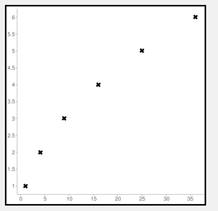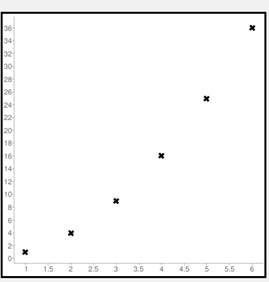
a.
To explain:The data represented in the complete table is a function or not.
a.
Answer to Problem 20HP
The complete table is provided below,
The data in the table represents the function.
Explanation of Solution
Given information:
The table,
Formula used:
A relation is said to be a function if every element of domain is mapped to exactly one element of range.
Calculation:
Consider the table,
Here the x represent the number that is square of a whole number.
And y represent the positive square root of the number x .
So, square root of 4 is 2, 9 is 3, 16 is 4 and 36 is 6.
Also square of 5 is 25. Therefore, complete table is.
Recall that relation is said to be a function if every element of domain is mapped to exactly one element of range.
The elements of domain are
Each member of domain is mapped to exactly one element of range. Therefore, it represent a function.
b.
To graph: The
b.
Explanation of Solution
Given information:
The data is provided below.
Graph:
When the relationship between two data sets is to be analyzed scatter plot is used.
Provided two data sets. Here the x represent the number that is square of a whole number.
And y represent the positive square root of the number x .
On the x -axis of coordinate plane denote the number from 1 to 40.
On y -axis plot denote the number from 1 to 6.
The scatter plot of the data is provided below,

Interpretation:
It is observed as the square of whole number increases its square root value also increases that is there is a strong positive linear relationship between x and y .
c.
To explain:The data represented in the complete table when the x and y coordinates are revered is a function or not.
c.
Answer to Problem 20HP
The complete table is provided below,
The data in the table represents the function.
Explanation of Solution
Given information:
The table,
Formula used:
A relation is said to be a function if every element of domain is mapped to exactly one element of range.
Calculation:
Consider the table,
Here the x represent the number that is square of a whole number.
And y represent the positive square root of the number x .
Now, reverse the x and y coordinates.
So, square root of 4 is 2, 9 is 3, 16 is 4 and 36 is 6.
Also square of 5 is 25. Therefore, complete table is.
Recall that relation is said to be a function if every element of domain is mapped to exactly one element of range.
The elements of domain are
Each member of domain is mapped to exactly one element of range. Therefore, it represent a function.
d.
To graph: The scatter plot between whole number and square value of the whole number.
d.
Explanation of Solution
Given information:
The data is provided below.
Graph:
When the relationship between two data sets is to be analyzed scatter plot is used.
Provided two data sets. Here the x represent the whole number.
And y represent the square value of the number x .
On the x -axis of coordinate plane denote the number from 1 to 6.
On y -axis plot denote the number from 1 to 40.
The scatter plot of the data is provided below,

Interpretation:
It is observed as the whole number increases its square value also increases that is there is a strong positive linear relationship between x and y .
Chapter 1 Solutions
Pre-Algebra, Student Edition
Additional Math Textbook Solutions
Calculus: Early Transcendentals (2nd Edition)
A Problem Solving Approach To Mathematics For Elementary School Teachers (13th Edition)
Algebra and Trigonometry (6th Edition)
Basic Business Statistics, Student Value Edition
Using and Understanding Mathematics: A Quantitative Reasoning Approach (6th Edition)
- InThe Northern Lights are bright flashes of colored light between 50 and 200 miles above Earth. Suppose a flash occurs 150 miles above Earth. What is the measure of arc BD, the portion of Earth from which the flash is visible? (Earth’s radius is approximately 4000 miles.)arrow_forwarde). n! (n - 1)!arrow_forwardSuppose you flip a fair two-sided coin four times and record the result. a). List the sample space of this experiment. That is, list all possible outcomes that could occur when flipping a fair two-sided coin four total times. Assume the two sides of the coin are Heads (H) and Tails (T).arrow_forward
- e). n! (n - 1)!arrow_forwardEvaluate the following expression and show your work to support your calculations. a). 6! b). 4! 3!0! 7! c). 5!2! d). 5!2! e). n! (n - 1)!arrow_forwardAmy and Samiha have a hat that contains two playing cards, one ace and one king. They are playing a game where they randomly pick a card out of the hat four times, with replacement. Amy thinks that the probability of getting exactly two aces in four picks is equal to the probability of not getting exactly two aces in four picks. Samiha disagrees. She thinks that the probability of not getting exactly two aces is greater. The sample space of possible outcomes is listed below. A represents an ace, and K represents a king. Who is correct?arrow_forward
- Consider the exponential function f(x) = 12x. Complete the sentences about the key features of the graph. The domain is all real numbers. The range is y> 0. The equation of the asymptote is y = 0 The y-intercept is 1arrow_forwardThe graph shows Alex's distance from home after biking for x hours. What is the average rate of change from -1 to 1 for the function? 4-2 о A. -2 О B. 2 О C. 1 O D. -1 ty 6 4 2 2 0 X 2 4arrow_forwardWrite 7. √49 using rational exponents. ○ A. 57 47 B. 7 O C. 47 ○ D. 74arrow_forward
 Algebra and Trigonometry (6th Edition)AlgebraISBN:9780134463216Author:Robert F. BlitzerPublisher:PEARSON
Algebra and Trigonometry (6th Edition)AlgebraISBN:9780134463216Author:Robert F. BlitzerPublisher:PEARSON Contemporary Abstract AlgebraAlgebraISBN:9781305657960Author:Joseph GallianPublisher:Cengage Learning
Contemporary Abstract AlgebraAlgebraISBN:9781305657960Author:Joseph GallianPublisher:Cengage Learning Linear Algebra: A Modern IntroductionAlgebraISBN:9781285463247Author:David PoolePublisher:Cengage Learning
Linear Algebra: A Modern IntroductionAlgebraISBN:9781285463247Author:David PoolePublisher:Cengage Learning Algebra And Trigonometry (11th Edition)AlgebraISBN:9780135163078Author:Michael SullivanPublisher:PEARSON
Algebra And Trigonometry (11th Edition)AlgebraISBN:9780135163078Author:Michael SullivanPublisher:PEARSON Introduction to Linear Algebra, Fifth EditionAlgebraISBN:9780980232776Author:Gilbert StrangPublisher:Wellesley-Cambridge Press
Introduction to Linear Algebra, Fifth EditionAlgebraISBN:9780980232776Author:Gilbert StrangPublisher:Wellesley-Cambridge Press College Algebra (Collegiate Math)AlgebraISBN:9780077836344Author:Julie Miller, Donna GerkenPublisher:McGraw-Hill Education
College Algebra (Collegiate Math)AlgebraISBN:9780077836344Author:Julie Miller, Donna GerkenPublisher:McGraw-Hill Education





